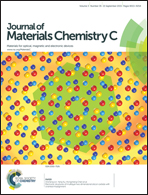Multiple stimuli-responsive and reversible fluorescence switches based on a diethylamino-functionalized tetraphenylethene†
Abstract
Tetra(4-(diethylamino)phenyl)ethene (TPE-4N), a new derivative of tetraphenylethene (TPE), is facilely prepared in one step from bis(4-(diethylamino)phenyl)methanone in a good yield of 85%. TPE-4N shows aggregation-induced emission (AIE) with high solid-state fluorescence quantum yields up to 63.5%. It has strong proton capture capability, allowing for reversible fluorescence switching in acidic and basic solutions. A good linear relationship between the emission intensity and the pH value ranging from 4.4 to 6.0 is established. By exposing to hydrochloride vapor, the color of TPE-4N powder is changed from yellow-green to white, accompanied by a fluorescence color change from green to sky-blue. The resulting protonated luminogen (p-TPE-4N) can be readily reverted to TPE-4N by fuming with hot triethylamine vapor. The protonation and deprotonation processes are reversible and can be repeated many times without fatigue in the solid state. In addition, p-TPE-4N exhibits reversible thermochromism between 80–120 °C, and reverts to TPE-4N by heating up to 120 °C. Multiple stimuli-responsiveness and reversible fluorescence indicate that TPE-4N is a promising candidate for chemical sensing and environmental monitoring.


 Please wait while we load your content...
Please wait while we load your content...